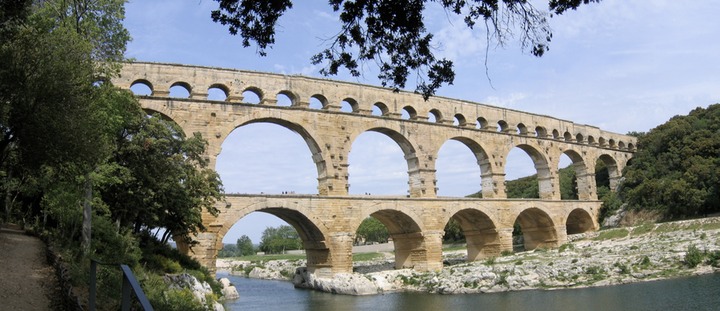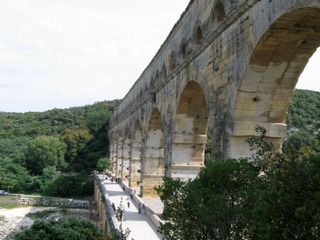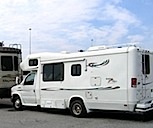Some of you, like one of Susan’s geographically-challenged siblings, have suggested that we include maps so our readers can see for themselves where we are. It’s a good idea, but we haven’t been able to download a map that we can write on, so let’s do this instead:
1. Find a map of France. Actually, it doesn’t even have to be all of France--just the Mediterranean coast will do. (Already you can tell where this is going, right?)
2. Find Cannes. That’s the town with the sun and the beaches and the yachts and the film festival, where the B-grade actresses take off their clothes in front of the photographers for publicity. It’s right on the ocean.
3. Now go east a bit, staying right on the ocean, until you find Nice. There’s no film festival there, but there’s sun and beaches and yachts, and everything else you’d expect in a town called “Nice,” even if they do pronounce it “Neese” for some reason.
4. Now go halfway between Cannes and Nice. Be sure to stay right on the ocean.
That’s where we are.
What looks like low clouds are actually the Italian Alps. Oh, and it was about 80 degrees today, so we had to put the awning up to protect ourselves from the sun while we sipped our wine.
Have we mentioned that being retired is tough, but we’re determined to make it work?
We’re here because since our last entry we’ve been heading slowly toward a little town on the Italian coast called Arenzano, just west of Genoa, which is the finish line for May 20’s stage in the three-week bike race through Italy called the Giro d’Italia.
On the way to the Mediterranean coast, we visited what is probably the oldest manmade structure we’re going to see. We stopped for a night just a short walk from the Pont du Gard, a 2000 year old aqueduct built by the Romans to bring water to Nimes. Most of it still stands tall over the River Gardon, and a pedestrian bridge has been built right up against it to accommodate the large numbers of tourists. The footbridge very cleverly mimics the original in construction design and materials, so the two blend together very well. We didn’t know it wasn’t part of the original until we were almost on it. There was a large pay parking lot adjacent (which we did not have to use since Rover was at the campground), but that was the only part of the site that carried any charge. There was also no tourist information booth or anyone selling cold drinks or souvenirs, even though there was plenty of room for all of that on the long and wide approach path to the bridge. Someone is missing a golden opportunity here because there are thousands of visitors every year. We were surprised at the large number there on the day we visited.


The next day we drove to Avignon, but not without incident. We had stopped at a large grocery store and checked out their gas station for access. It is one of those that has five or six pumps side by side, after which everyone drives past a pay booth at the exit. We had gotten gas and were next in line to pay before discovering that our 8’3” wide Rover (with the mirrors folded in) would not fit through their 8’2” exit lane. The only way out was to back up through the pump area and exit the way we had come in. The cashier called security, but by this time the few cars behind us had figured out what was happening and gotten around us, while David did a remarkable job of backing Rover up between the pumps, despite another car being fueled next to us. The security man arrived and waved a few cars out of our way, and we turned around and were off. It was embarrassing, but we survived, and we did not tear the awning off!
(At the risk of seeming to write about nothing but motoring hazards):
Finding a place to park in Avignon itself was nearly impossible. We managed to get ourselves into a couple of tight spots there, too, before finally seeing a sign for motorhome parking that ended up being across the river. However, it turned out to be very handy, as a free bus was provided from the large parking lot there.
Avignon was home to the popes in the 1200’s. Since we had already toured the large Palace of the Popes in 2004 when we followed the Tour de France, we took the little train ride around the old city streets and alleys. We enjoyed the ride itself more than the sights being pointed out to us, and could not believe the tight corners the driver managed to pull us through and around. We continued on to Aix-en-Provence later in the day.
We had bought a clothes drying rack because most campgrounds don’t want you to attach clotheslines to trees. (Most also do not allow campfires or even charcoal cooking fires.) At Aix we were able to do a couple of loads of laundry and dry it pretty quickly in the sunshine. The next day we took the bus to the city center. Aix was the home of Paul Cezanne, and when we went to the museum, we found it was free--for a good reason: they were in the process of setting up a Picasso/Cezanne exhibit and had most of the rooms blocked off, so we were unable to see a single painting by either of them. Ah, well--this is only the second time something like that has happened in two trips.
Aix (pronounced ex) is a beautiful city with a wide central boulevard lined with sycamores, the tree of choice in France. This boulevard was lined with cafes and restaurants spilling out on the wide sidewalks. On part of our walk we encountered a crowd of people and discovered a movie scene being filmed at one of the sidewalk cafes. Most exciting, we also found an English language bookstore that had a whole week’s worth of Herald Tribunes free for the reading. And we got to sit down for half an hour.
After two nights in Aix we drove on to revisit the little village that had captured our imagination so much on our Tour de France trip. La Cadiere d’Azur, high on a hill in Provence wine country, is yet another of France’s very old villages with tiny streets and steps masquerading as streets. It has great parking outside the village center, where we parked and walked all around (in the rain)--it isn’t very big. From the north, one can see for miles from east to west over the vineyards. It is just a lovely place and looks like it has been there for ever. But because it was raining we didn‘t try to extend our stay but instead drove on to the Mediterranean coast.


When we pick a destination out of one of our guidebooks, we are never sure just where the campgrounds will be. We usually try to find something close to city centers or on a bus line, but this time we were looking for a beach. We ended up at La Tour-Fondue on the Giens Peninsula, the southernmost point on the Cote d’Azur. We were surprised at the campground’s low €15/day price because this has to be one of the most expensive pieces of real estate we have every stayed at. The campground itself was nothing special--actually, it was a little worn looking, with some steep driveways and low trees for Rover to navigate--but we could see the Mediterranean from our window. It was a ten minute walk (in the rain again) to the ferry docks and a little rocky beach and an old fortress on the farthest point. On Saturday, when the sun was shining, we walked around again and watched the boats head out with scuba divers for the day. And we could see the islands and ships out at sea. But we stayed only one night because we are need to get closer to northwestern Italy.

And now we are between Cannes and Nice on what is certainly another expensive property. This campground’s laundry was only € 5 ($6.75) to wash and dry a load, the cheapest we have seen, so we did two loads of laundry! And then we walked the rocky beaches. We plan to come back to this place next week after seeing the stage of the bike race. It is right on a bus and train line that would make visiting Cannes, Nice and Monaco very easy, and it would be nice to just stay in one place for a while and not have to think about driving.

